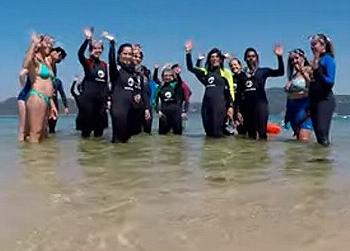
NEW YORK, New York, September 22, 2019 (ENS) – Young people from Portugal, Brazil, and the United States have won the 2019 Global Youth Video Competition by telling inspiring stories of local climate action that can be scaled up and replicated around the world. The winners were announced Saturday at the UN Secretary-General’s Youth Climate Summit in New York.
In advance of this year’s edition of the Global Youth Video Competition, over 400 videos were entered by young people between the ages of 18 and 30 from 114 countries.
The three-minute videos were submitted in three categories, all focused on an aspect of environmental conservation: cities and local action to combat climate change, nature-based solutions for food and human health, and balancing the use of land for people and ecosystems.

Speaking at the Youth Climate Summit Niclas Svenningsen, manager with Global Climate Action at UN Climate Change, said, “The Global Youth Video Competition is turning the spotlight on action taken by youth around the world. Now more than ever, we need to engage youth in the international discussions. Their voices need to be heard at the upcoming UN Climate Action Summit and beyond.”
The winners, chosen through online public voting, are Raquel Gaião Silva from Portugal with her video “Ocean Alive,” Rafael Forsetto and Kiane Assis from Brazil with the video “What is Agroecology,” and Callie Broaddus from the United States for her video “Reserva: The Youth Land Trust.”
Category 1: Cities and local action to combat climate change
The winning video in this category by Raquel Gaião Silva presents the efforts made by the Portuguese NGO “Ocean Alive” to protect the seagrass meadows in Setúbal. The video describes how volunteers collaborate with marine scientists to learn about biodiversity and the scientific protocols for environmental quality assessments. “Ocean Alive” works to educate students and the local fishing community, in order to promote behavior change, reduce destructive fishing, and protect the seagrass meadows.
Category 2: Nature-based solutions for food and human health
In their winning video, Rafael Forsetto and Kiane Assis define agroecology and show how it has become part of the culture for farmers in Paraná, Brazil. These farmers avoid pesticides and seek to increase biodiversity and reduce the ecological impact of their agricultural practices. Through the Latin American School of Agroecology, they work to share their knowledge and good practices.
Category 3: Balancing use of land for people and ecosystems
This winning video by Callie Bradous of the United States describes how she and her late sister set up The Youth Land Trust to protect Ecuadorian forests. They aim to empower young people around the world and create the first entirely youth-funded nature reserve. Bradous strongly believes that if young people are given the adequate platform, they can bring the planet back into balance. Click here to find out more about The Youth Land Trust.

The 2019 Global Youth Video Competition was organized jointly by the three Rio Conventions: the Convention on Biological Diversity, the UN Framework Convention on Climate Change, and the UN Convention to Combat Desertification, in partnership with the Global Environment Facility-UNDevelopment Programme Small Grants Programme, and the BNP Paribas Foundation, a part of the Paris-based international bank.
The competition was implemented through the Television for Environment platform.
The winning and finalist videos will be shown Monday at UN Secretary-General Antonio Guterres’ Climate Action Summit, a one-day showcase of the concrete commitments governments are making to address climate change and to secure and improve the health and well-being of their citizens and the planet.
In December, the winners will travel to the UN Climate Change Conference (COP25) in Santiago, Chile, where they will attend the Global Youth Video Competition Award Ceremony. They also won assignments as youth reporters to assist with videos, articles and social media posts from the conference.
With 197 Parties, the United Nations Framework Convention on Climate Change (UNFCCC) has near-universal membership and is the parent treaty of the 2015 Paris Climate Change Agreement. The main aim of the Paris Agreement is to keep a global average temperature rise this century well below 2 degrees Celsius and to drive efforts to limit the temperature increase even further to 1.5 degrees Celsius above pre-industrial levels.
The UNFCCC is also the parent treaty of the 1997 Kyoto Protocol. The ultimate objective of all agreements under the UNFCCC is to stabilize greenhouse gas concentrations in the atmosphere at a level that will prevent dangerous human interference with the climate system, in a time frame which allows ecosystems to adapt naturally and enables sustainable development.
Copyright Environment News Service (ENS) 2019. All rights reserved.
© 2019, Environment News Service. All rights reserved. Content may be quoted only with proper attribution and a direct link to the original article. Full reproduction is prohibited.
